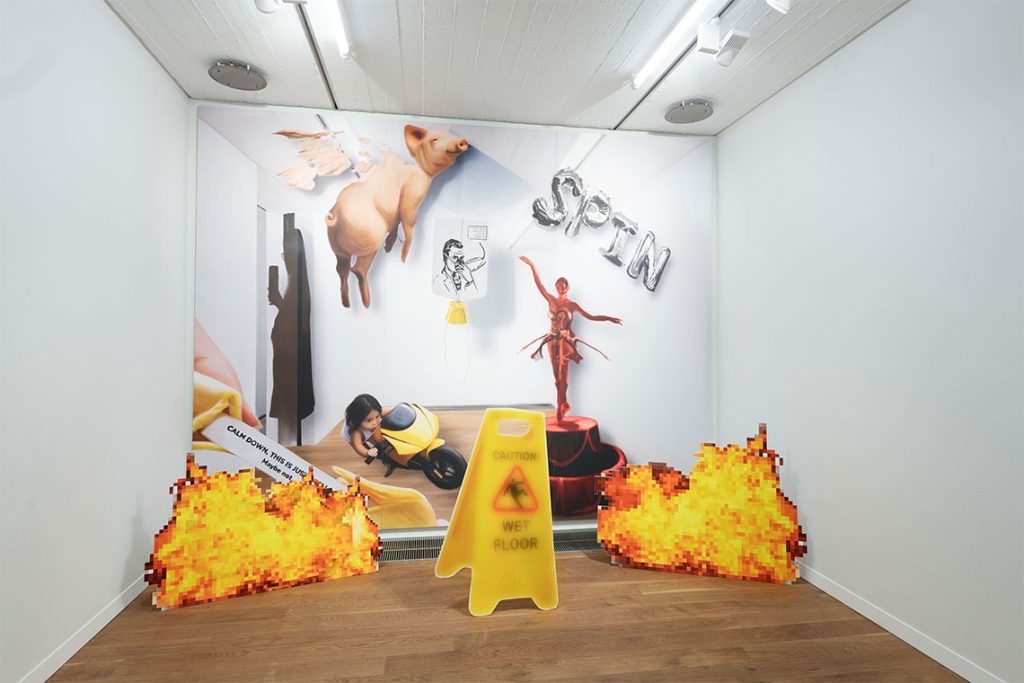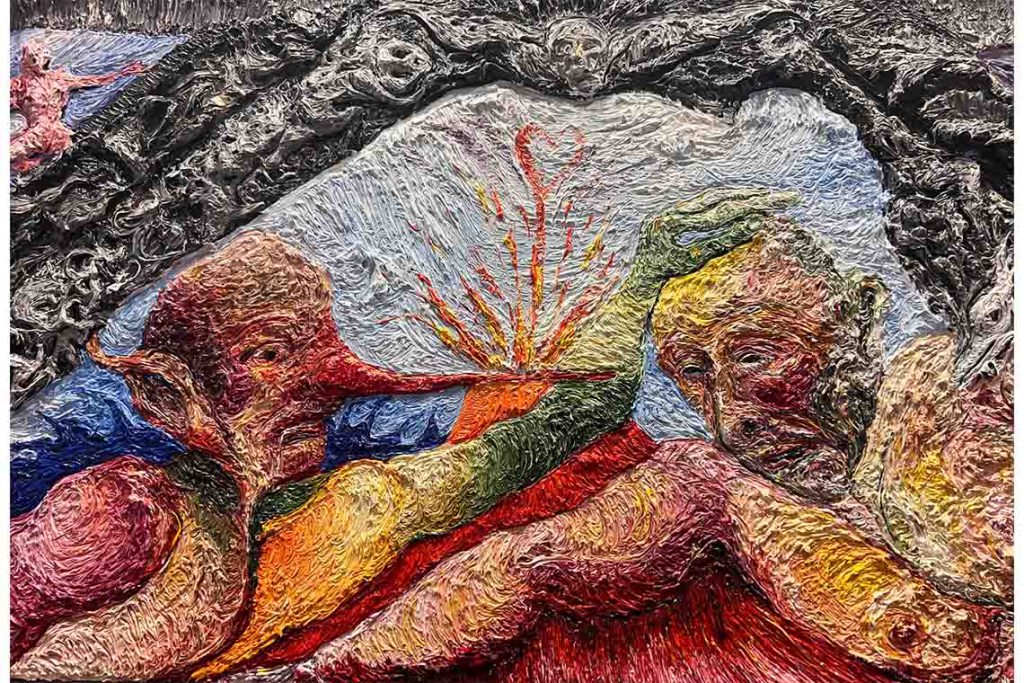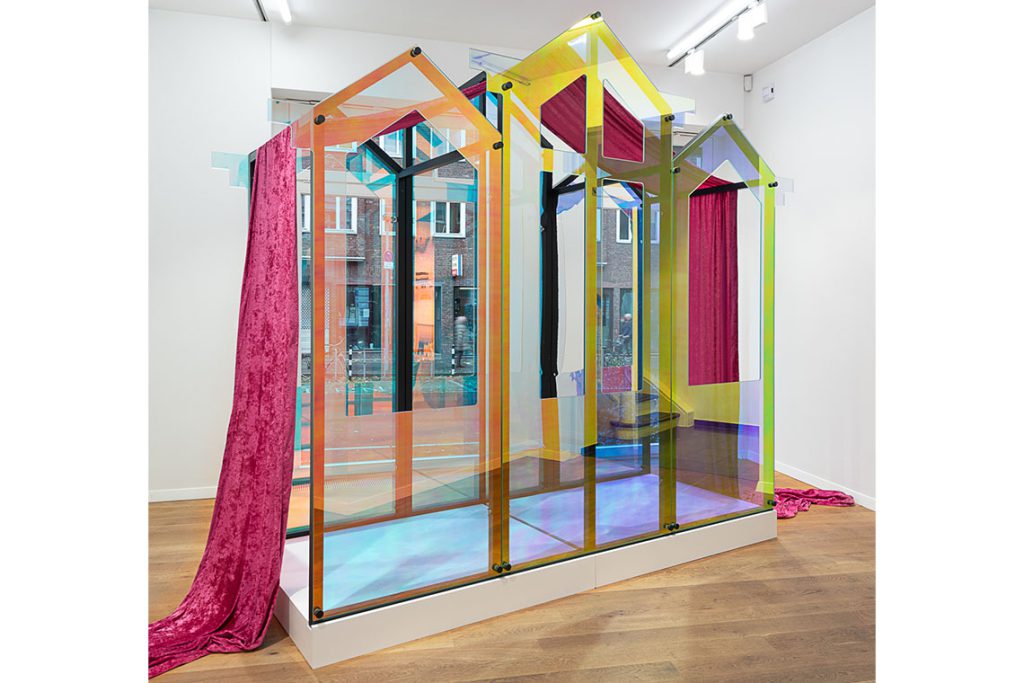The Turkish artist’s oeuvre embodies the technicolour chaos of childhood memories, social media personae and the performance of desire.
Lal Batman believes in the power nap. Quick escapes to the dream state have been the Istanbul-based artist’s secret to fuel energy for back-to-back exhibitions in the last few years. During late nights at her Beyoğlu studio or extended install days for her gallery shows and fair booths, she revels in 15 minute check-outs. Sleep, however, gifts Batman more than simple energy. “My dreams from the middle of the day provide me with so much inspiration,” she says. The artist’s psychedelic visual vocabulary in painting and sculpture has elements from her swift voyages to the subconsciousness. Just like fluid illusions oozing into our memory pool, the products of Batman’s mercurial visions are alarmingly everyday – they slyly communicate with their digital familiarity, yet assume bombastic scales and odd configurations. Selfie paintings with grotesque tweaks possess a twisted divinity; in some of her spray paint-and-resin paintings, piles of bodies contort to extremities, redefining a glitch with their bacchanalian corporeality.
Batman’s Anna Lauder gallery exhibition, Floor Is Lava, in Düsseldorf last winter included a massive cutout of the artist’s dozed-off face with a film projected onto the back wall. Not unlike a weightless dream, freely roaming icons – from Mexican street musicians to cows in the Swiss Alps – populated the moving image, while her Alice in Wonderland-esque gargantuan presence filled a small room. Batman, in fact, turned her likeness into a whimsy joke with a unibrow moustache and ‘DO NOT DISTURB’ drawn all over her face. An audio component sang to her slumber, featuring recordings of everyday sounds which she had collected from her trips around the globe, fittingly including Mexico and Switzerland.

Photography by Katja Illner. Image courtesy of Anna Laudel
The artist’s exuberant, chaotic and unapologetic lexicon lies in her commitment to an open-ended punch line. The oil-and-ink painting Divine Teardrop (2023) shows a door veiled in romantic blossoms and ornate mouldings, opening to a mountainous landscape. Egg yolks ooze from the lush ornamentation, stirring disgust with overt beauty. Three larger-than-life caterpillars creep on the parquet floor, releasing a trompe l’oeil effect which goes full throttle with tiny sculptures of fried eggs on the actual gallery floor. The vignette juggles between analogue and cyber, replicating the effect of visual data erupting from our screens.
Batman’s recent show, Cherry on Top, at Anna Lauder’s Bodrum space, explores internet carnality, the rituals of desire in front of a screen. Staged in the splashy summer town on the Aegean coast, the artist’s new paintings and sculptures acknowledge the surrounding decadence with work that stems from her memories and dreams. Densely coloured paintings replicate physical intimacy in front of volcanic eruptions or the decadent Amalfi coast. Totemic sculptures strip the body of desirability: thin cakey piles of stuff hide horrified faces as their molten skins blend into unfamiliarity. The excess of desire yields a surplus of imagery.

Batman is fascinated by the gnarly corners of social media – particularly Instagram – where secrecy best hides while exposure awaits right around the corner. “Instagram is full of guilty pleasures and things we want to express but cannot,” she says. “We use memes and tags to communicate in codes.” She believes the show is her most “transparent and unfiltered” expression while still thematically navigating the performance of identity and desirability, online and off. Layers, textures and shades inhabit a maximalist landscape in sync with our Instagram-trained eyes. Like wellness content flowing into our feed at the speed of light, Batman’s hyper-energetic figures – trinkets in boiling colours, two-headed swans, wet floor signs and low-res fire emojis – seep into our content-starving eyes.
“I like going between childhood memories and adulthood realities,” the artist admits, “because I can expose myself in ironic ways.” The heightened emotions of childhood games and the chaos of everyday life share similar inherent urges of survival. Whether constantly escaping from danger in a kids’ game or navigating the serpentine alleys of adulthood, chaos “keeps life dynamic”, she explains. She also admits to pursuing an “optimistic and playful” re-staging of the unpredictable, both about the memories of the playground and the obstacles of life outside.
Batman’s own navigation of playfulness is an exercise which she compares to “playing hide-and-seek” with her own self. “I’ve learned how to use the humour inside me,” she says. Appreciating at an early age the potential of art to hone a balance between whimsy and provocation, she went to a high school that specialised in fine art in the northwestern city of Bursa in Türkiye. There, she developed an interest in graphic design and sculpture, which both continue to cast their influences on her practice. “I have always had multilayered interests,” says the 22-year old, “I can’t concentrate on just one way of thinking.” She moved to Istanbul in 2019 for an undergraduate degree in plastic arts from the Yeditepe University.

Photography by Katja Illner. Image courtesy of Anna Laudel
Paying particular attention to keeping her material palette versatile, Batman uses, in addition to oil paint, engraving, ink and giclée print, all filtered through Gen-Z instincts. Flirting with the inescapable cacophony, she stirs parameters of logic, satire and play. A native of the digital, she pokes at the tactile distinctions between the pixelated and the analogue. Part self-portraits and part selfies, her Identities series (2021–23) comprises mixed-media paintings in which the artist’s face goes through distortions similar to social media’s face-altering applications. Stretched, blown-up, fragmented, Batman’s own visage salutes one of the thematic pillars of art history, yet with her direct gaze directed at us, her head slightly tilted in the typical selfie pose. The gesture is what she calls the “auto-portrait of the 21st century”, in which facial emotionality is crafted for an audience beyond the physical painting’s supposed viewer. She performs versions of a persona with the assumption of a logged-in user versed in the ritualised postures of social media.
Batman remembers the day when her dad brought her first computer from his office. Memories, in general, are laid out in her brain in an order which she compares to a desktop. “Whenever I need to visualise an instant, I can go back to that album and pull a memory,” she admits. Therefore, she does not differentiate a childhood memory from a quick nap’s dream: “If you are able to dream something, then it is a memory, too.” This slippery distinction between a lived experience and a fantasy is akin to how Batman translates her musings into art. “If I turn a dream into a painting, then it becomes reality, doesn’t it?”



